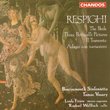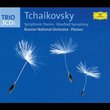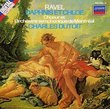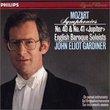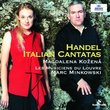| All Artists: Geoffrey Simon, Alexander Baillie, Leslie Pearson, The Philharmonia Title: Ottorino Respighi: The Ballad of the Gnomes / Adagio with Variations for Cello & Orchestra / Three Botticelli Pictures / Suite in G major for Strings & Organ - The Philharmonia / Geoffrey Simon Members Wishing: 0 Total Copies: 0 Label: Cala Original Release Date: 11/20/2006 Release Date: 11/20/2006 Genre: Classical Styles: Chamber Music, Forms & Genres, Concertos, Theatrical, Incidental & Program Music, Instruments, Strings Number of Discs: 1 SwapaCD Credits: 1 |
Search - Geoffrey Simon, Alexander Baillie, Leslie Pearson :: Ottorino Respighi: The Ballad of the Gnomes / Adagio with Variations for Cello & Orchestra / Three Botticelli Pictures / Suite in G major for Strings & Organ - The Philharmonia / Geoffrey Simon
CD DetailsSimilar CDsSimilarly Requested CDs
|
CD ReviewsIf Fountains is your favorite, get this CD! Paul Powers | Tampa, FL United States | 07/15/2001 (5 out of 5 stars) "I say this because the consummate master of orchestration, Ottorini Respighi, will not disappoint fans of his most popular works -- his Roman Triptych (Roman Festivals, Fountains of Rome, and Pines of Rome). My personal favorite is Fountains, and this brings me to the richly luminescent and awe-inspiring pieces contained in this recording. The world premiere recording of The Ballad of the Gnomes, was composed during the time of the triptych (1920s), and is very similar to those tone poems. However, the feel of this tone poem differs because its story-line is based on Carlo Clausetti's poem Ballata delle gnomidi; a myth-based story of an innocent male dying at the hands of some very amoral females (gnomes). Similar to the myth of the Sirens luring seamen to thier deaths. In this tone poem Respighi weaves a very sinister mood throughout a turbulent score that brings to mind the undulating waves of Debussy's La Mer. For this reason, this piece, and the third movement of his Three Botticelli Pictures, reminds me of Fountains of Rome. The Adagio with Variations for Cello and Orchestra (Alexander Baillie, cello) is an extraordinary piece. The piece in one movement is rather short but very evocative and mellow. The orchestration and Respighi's usual transparency of voice bring a lovely, fantasy quality; especially to the end of the piece. I was so inspired by the piece, that being a bassoon player myself, I transcribed the piece for bassoon and piano (after having found that Respighi had originally written it for cello and piano and was asked to expand it for orchestra by a cellist friend whom the piece is now dedicated). Mr. Baillie is a master of the nuances and intricacies of the piece and performs it exquisitely. The Three Botticelli Pictures is a rather well-known piece in three movements depicting three separate, yet equally famous paintings by the 15th-century master Sandro Botticelli. The first movement Spring is full of horn calls evocative of Roman Festivals or Beethoven's 6th Symphony. The light mood of the piece is portrayed through varying string tremolos and the dancing meters throuhgout the winds. The second movement is a depiction of The Adoration of the Magi. A very solemn, solo bassoon is heard throughout the piece, weaving his music into and out of harmony with oboes playing the familiar 'O Come, O Come, Emmanuel.' A brief rhythmic interlude of piano, celeste, and harp suggest the trek of the Magi en route to the Christ-child. As I mentioned before, the third movement bears a striking resemblance to The Fountains of Rome. However, here the Birth of Venus, is not as tumultuous as the middle movements of Fountains. The gentle strings give a tremulus birth to the goddess and in a very Respighian crescendo, the piece climaxes and the same undulating strings carry the beauty out to sea. The final piece on the album is The Suite in G Major for Strings and Organ. Very baroque and Bach-like, Respighi based this piece on the old-style concerto grosso. The Preludio is very straight forward in it's intent, but the flourish of Respighian orchestration makes one wonder what Bach may have composed if he lived with the large orchestras of today. The sweeping string scales and the grandeur of the organ's first entrance are a fitting segue into a beautifully somber Aria that is the second movement. The fugue-like quality of the third movement's Pastorale is rich with the luminescent string voicing that Respighi is known for. The striking first chord of the final movement's Cantico is similar to Saint-Saens' final movement of his 3rd Symphony. The interplay between string voicing and between strings and organ come to many an urgent front before the piece ends. The listener almost wishes Respighi had written this last movement to include a chorus. However the majesty of the entire composition is by no means diminished without one, due to Respighi's omnipresent skill in orchestration. I am sure that if you enjoy anything Respighi; from his large works like The Pines of Rome to his smaller orchestrations of Ancient Airs and Dances; there will be something to match every taste on this recording. I hope you enjoy it as much as I do." Respighi's catalogue MUST be celebrated! G. Stewart | Chesapeake, VA USA | 07/02/2007 (5 out of 5 stars) "Respighi, best known for his compositions of Rome, "Roman Festivals", "The Pines of Rome" and "The Fountains of Rome" and somewhat lesser known for his "Ancient Dances and Airs" has composed many other wonderful works and this album is a perfect sampling of those other works. "Three Botticelli Pictures" of which "The Birth of Venus" is most beautiful (perhaps one of the greatest compositions ever, in my humble opinion), "Adagio with Variations" (pure ear candy for lovers of the Adagio), and "Suite in G major" which is very much in the vein of Camille Saint-Saens (one of my other favorite composers) in its inclusion of and consumption by the organ, all are wonderful excursions in to this genius' lesser known works. "The Ballad of the Gnomes" is a tone poem in the style of Respighi's Rome Trio, but it also has the dark and ominous feel of his lesser known "Metamorphoseon Modi XII". This album would be a wonderful addition to any classical collection and is highly recommended to anyone that is just learning of this wonderful Italian composer or who has been limited to only his more famous works. A highly recommended album for anyone who loves orchestrations in the grand style of the true greats such as Bach, Handl, Brahms or Mozart. Please, do yourself a favor and buy this CD." Seldom Played But Some of Respighi's Best D. A Wend | Buffalo Grove, IL USA | 05/08/2008 (5 out of 5 stars) "I have had this disc since it came out in 1992 and I prize it for the marvelous little-heard music of Ottorino Respighi that it contains. This was the World Premiere Recording of the Ballad of the Gnomes, a marvelous tone-poem from 1918 that was based on a poem (which is reproduced in the booklet). These are not garden gnomes and the music describes a ceremony where two wife gnomes put their husband gnome to death in a grizzly way and, once the deed is done, perform a wild dance while they consign their murdered husband to a watery grave. The music is very effective in depicting the gruesome undertaking and is a fine example of Respighi's masterful orchestration.
The Adagio with Variations for Cello and Orchestra could not be more different. The music is a beautiful evocation of nature with a somewhat melancholy melody that nicely captures the singing capabilities of the cello. This was possibly planned as a full cello concerto but the composer never completed it. The Three Botticelli Pictures has ling been a favorite of mine and here the work receives a brilliant performance. The three movements depict Botticelli's Primavera, The Adoration of the Magi and The Birth of Venus. The music is evocative of the paintings they depict with trills announcing the arrival of spring and a gentle melody suggesting the movement of water for the Birth of Venus with the sounds of Gregorian chant reflected in the Adoration. The final work is a Suite for Strings and Organ that looks back to the music of Vivaldi and the Neapolitans. The Aria movement is of special note for its soaring melody that is comparable to Bach's famous Air of the G string. The Pastorale is a bit dark and reflective movement with the organ adding a somber accompaniment. The closing Cantico begins boldly with organ and orchestra then becomes reflective before retuning the opening melody that brings the music to a glorious conclusion. Geoffrey Simon has always been a great interpreter of the music of Respighi and does a marvelous job with this less-familiar program. The Phailharmonia plays beautifully and the soloists, cellist Alexander Baillie and organist Leslie Parsons, play with great sensitivity: an outstanding disc. " |


 Track Listings (9) - Disc #1
Track Listings (9) - Disc #1![Offenbach: Gaïte parisienne; Rossini-Respighi: La boutique fantasque [Hybrid SACD]](https://nationalbookswap.com/cd//m/94/2894/6122894.jpg)

